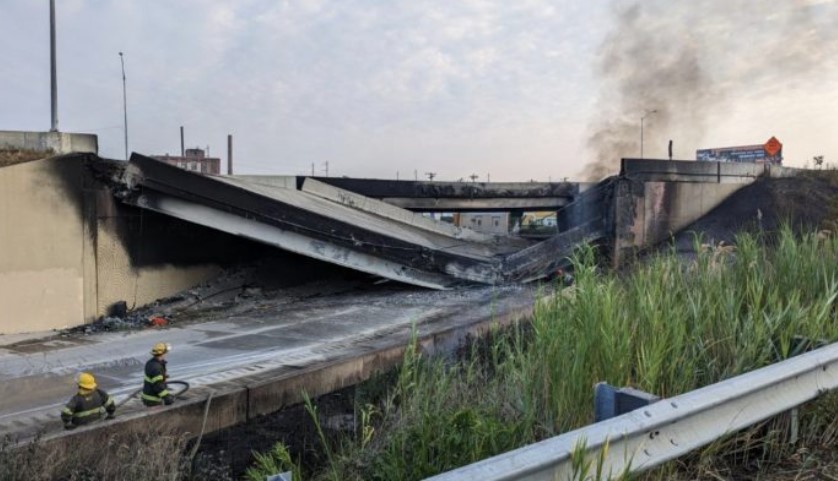In a startling turn of events, an overpass collapse in Philadelphia has led to the closure of a significant section of Interstate 95. While the incident is concerning, the good news is that no injuries have been reported thus far. This article comprehensively overviews the overpass collapse, its impact on traffic and infrastructure, and the ongoing response efforts. By examining the causes, consequences, and swift actions taken, we aim to shed light on this critical incident.
The Overpass Collapse Incident:
On 11 June 2023, a section of an overpass spanning Interstate 95 in Philadelphia suddenly collapsed, leading to a complete shutdown of the affected segment. The incident occurred during [time] and has since triggered a comprehensive response from emergency services and transportation authorities.
Causes and Investigations:
Initial investigations suggest that the overpass collapse may be attributed to structural failures or other factors compromising its integrity. Engineering teams and investigators are conducting a thorough examination to determine the exact cause and assess the overall condition of the infrastructure.
Traffic Disruptions and Commuter Impact:
The closure of Interstate 95 due to the overpass collapse has resulted in significant traffic disruptions, affecting commuters, businesses, and transportation logistics. The impacted section of the interstate is a critical artery for local and interstate travel, resulting in substantial detours and delays for drivers. Transportation authorities are working diligently to alleviate the congestion and provide alternative routes.
Public Safety Measures and Evacuations:
Public safety remains the top priority in the aftermath of the overpass collapse. Local authorities swiftly implemented necessary safety measures, including evacuating nearby buildings and cordoning the affected area. These proactive steps have helped to prevent potential injuries and ensure the well-being of residents and passersby.
Emergency Response Efforts:
Emergency response teams, including firefighters, police, and medical personnel, promptly mobilized to address the overpass collapse. Their coordinated efforts focused on conducting search and rescue operations, assessing potential hazards, and providing any necessary medical assistance. The efficient response has contributed to the absence of reported injuries, highlighting the effectiveness of preparedness and rapid intervention.
Collaborative Approach and Restoration Plans:
Multiple stakeholders, including government agencies, transportation authorities, and engineering experts, are collaborating closely to mitigate the overpass collapse’s impact. This collaborative approach expedites the assessment, planning, and execution of necessary repairs to reopen the affected section of Interstate 95 promptly.
Ongoing Traffic Management and Alternative Routes:
Recognizing the critical importance of Interstate 95, transportation authorities have established robust traffic management strategies to minimize disruptions and provide alternative routes for affected commuters. Regular updates, real-time traffic information, and detour guidance are being communicated through various channels to ensure smooth traffic flow and facilitate travel planning for motorists.
Long-Term Infrastructure Resilience:
The overpass collapse incident underscores the importance of ensuring the long-term resilience of critical infrastructure. It serves as a reminder of the need for rigorous inspections, maintenance, and investment in infrastructure projects to safeguard public safety and support economic activities. Authorities will likely undertake comprehensive evaluations of similar structures to identify potential vulnerabilities and take necessary preventive measures.
Conclusion:
The overpass collapse incident in Philadelphia, resulting in the closure of Interstate 95, has prompted a swift response from emergency services and transportation authorities. Although traffic disruptions have been significant, the fortunate absence of reported injuries reflects effective emergency management and rapid intervention. As investigations continue to determine the cause of the collapse, collaborative efforts are underway to restore the affected infrastructure and minimize long-term disruptions. The incident serves as a reminder of the importance of proactive infrastructure maintenance and investment to ensure the resilience and safety of critical transportation networks. Moving forward, authorities must prioritize infrastructure resilience, conduct regular inspections, and implement necessary maintenance measures to prevent similar incidents in the future. In summary, the overpass collapse incident in Philadelphia that led to the closure of Interstate 95 has brought attention to the importance of infrastructure safety and emergency response preparedness. While the traffic disruptions have posed challenges for commuters and businesses, the absence of reported injuries reflects the effectiveness of the emergency response efforts. Ongoing investigations and collaborative initiatives will help determine the cause of the collapse and guide future infrastructure improvements. By prioritizing infrastructure resilience and investing in regular maintenance, we can ensure the safety and reliability of critical transportation networks to benefit the public and the economy.

